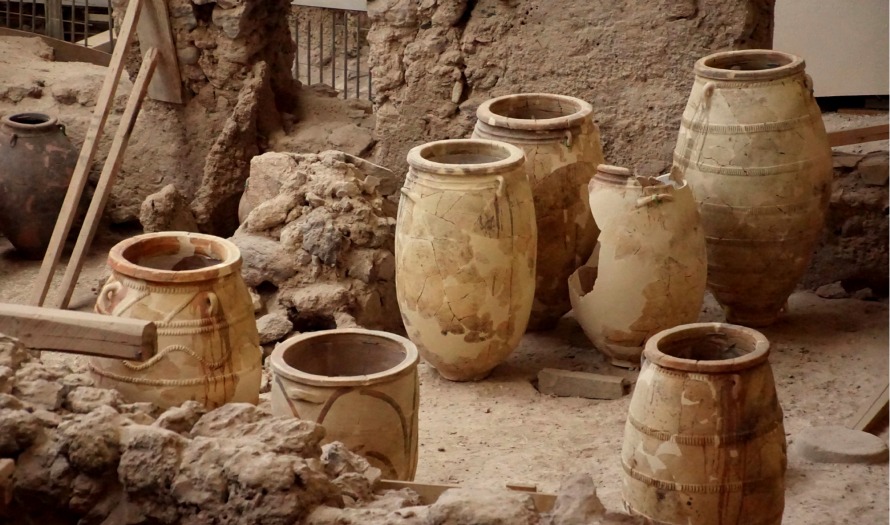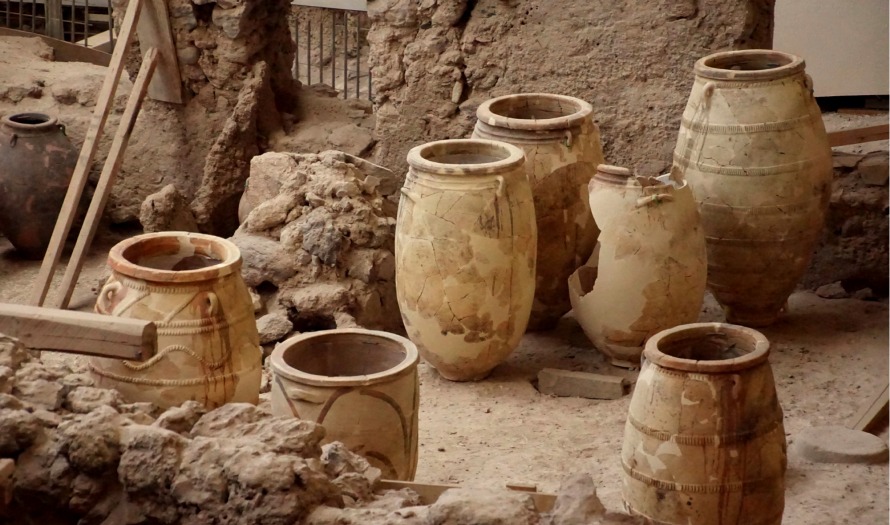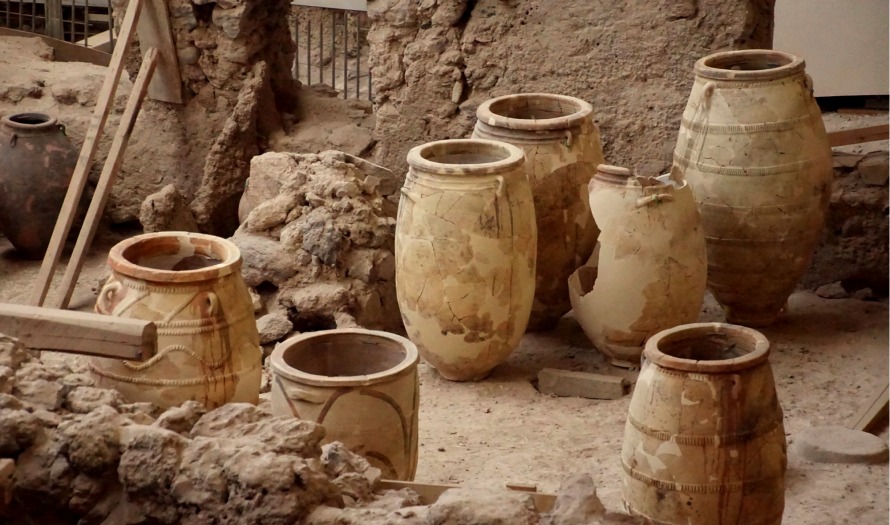General information
It is 12 km. far from Fira and has about 3,000 inhabitants. It is the biggest village on the island. People from Akrotiri, Perissa, Perivolos, Megalohori often come here to shop and tourists make a stop to take supplies on their way to the beaches.
The might not realize it, but they continue an old tradition. According to Fr. Richard, who came in Santorini during the second half of the 17th century, Emporio was the place of sale of all kinds of commodities and it is quite clear to assume that the market place was also the production place.
In the village visitors will also find cafes and taverns.
The most important attraction in Emporio is the medieval castle, a masterpiece in terms of architecture and well preserved since most of its building have been restored.
The castle and the Goulas
From the moment the visitor enters the castle he realizes that this is a small labyrinth, with alleys just wide enough for a person to go by, between staircases climbing almost vertically up to miniature balconies. There are doors in a row, seeming to lead nowhere, overhead bridges between houses, arches, domes –all characterized by the renowned plasticity of the malleable volcanic material. The irregular, flowing shapes and forms are astonishing. The castle belongs to the type of fortified settlement that derived from the original core with the surrounding defensive wall again created by the outer houses forming an unbroken line. The settlement was erected close to the Goulas (medieval fort).
Within the castle there is the church of Evaggelismos tis Theotokou (Annunciation of Virgin Mary), or Panagia (Virgin Mary) Messiani, which is dated by I. Koumanoudis in the 16th century, or earlier. It has been restored.
Outside the settlement, but only within a stone’s throw, is the Goulas and 50 m. away from it Aghia (St) Kyriaki’s church with its two chappels -Ierarches and Aghios (St) Artemios. I. Koumanoudis dates the church back to the15the or 16th century and it is influenced by the architectural style of Theotokaki church in the castle of Pyrgos.
The Goulas used to be the fort that provided protection to the lords and their peasant farmers. It was also the place to keep their crops. It belonged to the Dargentas’ family and as soon as the danger or the pirates passed, it became a dependency of the Patmos monastery, inhabited by monks who were under the authority of Aghios Ioannis (St John) Theologos monastery.
In more recent years the settlement expanded covering an area outside the wall. A building worth mentioning is the primary school, built at the expenses of Andreas Syngros, in 1900.
- General information
-
General information
It is 12 km. far from Fira and has about 3,000 inhabitants. It is the biggest village on the island. People from Akrotiri, Perissa, Perivolos, Megalohori often come here to shop and tourists make a stop to take supplies on their way to the beaches.
The might not realize it, but they continue an old tradition. According to Fr. Richard, who came in Santorini during the second half of the 17th century, Emporio was the place of sale of all kinds of commodities and it is quite clear to assume that the market place was also the production place.
In the village visitors will also find cafes and taverns.
The most important attraction in Emporio is the medieval castle, a masterpiece in terms of architecture and well preserved since most of its building have been restored.The castle and the Goulas
From the moment the visitor enters the castle he realizes that this is a small labyrinth, with alleys just wide enough for a person to go by, between staircases climbing almost vertically up to miniature balconies. There are doors in a row, seeming to lead nowhere, overhead bridges between houses, arches, domes –all characterized by the renowned plasticity of the malleable volcanic material. The irregular, flowing shapes and forms are astonishing. The castle belongs to the type of fortified settlement that derived from the original core with the surrounding defensive wall again created by the outer houses forming an unbroken line. The settlement was erected close to the Goulas (medieval fort).
Within the castle there is the church of Evaggelismos tis Theotokou (Annunciation of Virgin Mary), or Panagia (Virgin Mary) Messiani, which is dated by I. Koumanoudis in the 16th century, or earlier. It has been restored.
Outside the settlement, but only within a stone’s throw, is the Goulas and 50 m. away from it Aghia (St) Kyriaki’s church with its two chappels -Ierarches and Aghios (St) Artemios. I. Koumanoudis dates the church back to the15the or 16th century and it is influenced by the architectural style of Theotokaki church in the castle of Pyrgos.
The Goulas used to be the fort that provided protection to the lords and their peasant farmers. It was also the place to keep their crops. It belonged to the Dargentas’ family and as soon as the danger or the pirates passed, it became a dependency of the Patmos monastery, inhabited by monks who were under the authority of Aghios Ioannis (St John) Theologos monastery.In more recent years the settlement expanded covering an area outside the wall. A building worth mentioning is the primary school, built at the expenses of Andreas Syngros, in 1900.
info
- Near Emporio you will find the beaches of Vlychada, Perissa and Perivolos.
- Traditionally, people who lived in Emporio were farmers and fishermen.
- In the entrance of the village (coming from Fira) you will see 8 windmills in a row, on Exomitis hill. The area is called Miloi (windmills).
The information about the castle is from the book “Santorini: Society and Shelter, 15th-20th century”, by Dr Dora Monioudi-Gavala/A publication of Lukas and Evangelos Bellonias Foundation.
